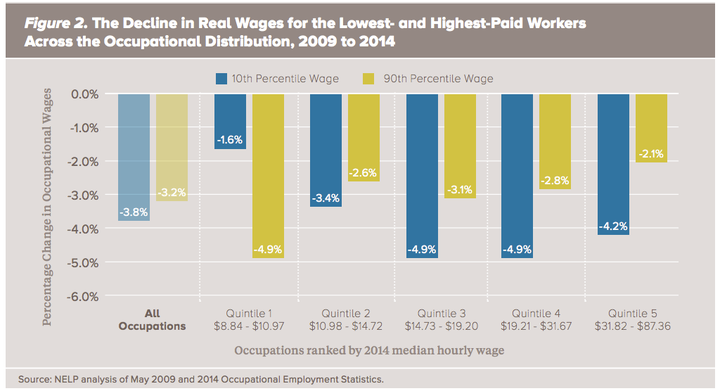Things are getting worse for the American worker.
A new report out by the National Employment Law Project shows declining real median wages for occupations across the income spectrum -- and the lowest-paid workers have been hit the hardest.

In the report, researchers at the NELP analyzed salary data from the Bureau of Labor Statistics' annual Occupational Employment Statistics report. They took median hourly wages for 785 occupations in 2014 and compared them to the median hourly wages for the same occupations five years prior. Adjusted for inflation, many occupations saw real hourly wages decline in those five years. In total, all occupations saw a 4 percent decrease in real median hourly earnings between 2009 and 2014.
The NELP report then divides the occupations evenly into five quintiles based on median hourly wage for each. The lowest-paying occupations, like food service workers and retail salespeople, are in quintile 1, and the highest-paying occupations, like lawyers and engineers, are in quintile 5. After dividing occupations into these buckets, the researchers found that, broadly, low-paid workers saw their real earnings decrease more on a percentage basis than high-paid workers.
One thing to say about these data is that they don't track individual workers, so this report doesn't exactly mean that a single person is seeing less in her paycheck in real terms today than she was in 2009 (although it's certainly possible). Declining real median wages could be a sign of demographic shifts: As older baby boomer workers retire and are replaced by a huge incoming cohort of millennials, those younger workers are paid lower salaries simply because they aren't as experienced.
That said, it's unlikely to be the entirety of what is going on here, especially at the low end. NELP policy analyst Claire McKenna pointed to the other chart in the report, a comparison of the 10th percentile of wages and the 90th percentile of wages in each of the quintiles. Basically, how did real wages change at the high and low end of each of these quintiles? She says it "offers some evidence that minimum wage policy can help have a moderating effect on wage stagnation."

Each of the quintiles -- except Quintile 1, the lowest -- show the same trend: Average hourly wages decreased more at the low end than at the high end. It's possible that this is bad news. "Some workers’ wages are so low that employers are not able to push them down any further," the paper says.
Indeed, the federal minimum wage, which currently sits at $7.25 an hour, has not been raised since 2009. However, there have also been several minimum wage increases in the last five years -- 22 states have increased their minimum wage, as well as large cities such as Washington, D.C., Los Angeles, San Francisco and Seattle -- which the NELP thinks has helped those at the very bottom.
